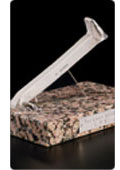A Great Canadian Legacy
July 19, 2012
A ceremonial silver spike intended to be the very last spike in the Canadian Pacific Railway. A diamond-studded silver business card case, a gift from the Duke of Connaught, the future Governor General of Canada. A sterling silver pass to Colorado’s Rio Grande Southern Railway. These extraordinary objects belonged to an extraordinary man: Sir William Cornelius Van Horne (1843–1915).
American-born railway magnate, business tycoon, fine arts collector, artist, gentleman farmer, senior figure in high society—Sir William Van Horne was all of these and more. His wide range of achievements and interests is reflected in a collection of roughly 250 objects and books recently donated to the Canadian Museum of Civilization by Sir William’s heirs.
Wide-Ranging Interests and Achievements
A man of immense energy, Sir William is best known as the driving force behind the building of the Canadian Pacific, Canada’s first transcontinental railway, which in 1885 linked the St. Lawrence–Great Lakes heartland and the developing West. Only 38 when he was enticed to Canada from the U.S. by Canadian Pacific’s board of directors, Van Horne already had a wealth of railway experience in the American West and Mid-West. Ultimately, he managed to finish the Canadian Pacific Railway five years ahead of schedule.
Van Horne’s entrepreneurial drive was relentless. After stepping down as President of Canadian Pacific in 1899, he led a syndicate that built Cuba’s first trunk railway system. As president of the Laurentide Pulp Company in Grand-Mère, Quebec, he helped pioneer wood-fibre paper-making in Canada. He was a director on the boards of forty companies in Canada, the U.S. and Britain during his career.
Yet business was just one of Sir William’s passions—another was art. He collected European and Canadian paintings, Japanese porcelain, Greek and Roman antiquities and various types of objects d’art, and was himself a competent, self-taught landscape painter.
“Sir William had an unusual combination of qualities,” says John Willis, Curator of Economic and Environmental History at the Museum of Civilization. “He had intense drive and energy and was very demanding, yet he was respected by his employees because he was willing to work all night if it was necessary. He had a strategic grasp of what railroads mean not just as a business, but as the basis for a whole modern industrial society. He cared deeply about art and artists and about his large family. He loved to be outdoors and in the country but was also an integral part of Montréal’s high society. This collection helps us understand a man whose unbounded enthusiasm for all of life helped shape Canada.”